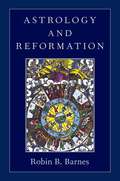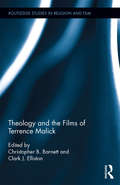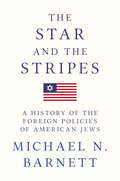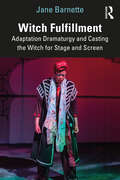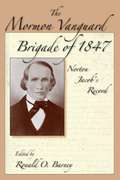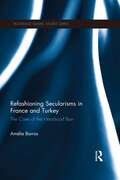- Table View
- List View
Astrology and Reformation
by Robin B. BarnesWinner of the 2016 Roland H. Bainton Book Prize of the Sixteenth Century Society and Conference During the sixteenth century, no part of the Christian West saw the development of a more powerful and pervasive astrological culture than the very home of the Reformation movement--the Protestant towns of the Holy Roman Empire. While most modern approaches to the religious and social reforms of that age give scant attention to cosmological preoccupations, Robin Barnes argues that astrological concepts and imagery played a key role in preparing the ground for the evangelical movement sparked by Martin Luther in the 1520s, as well as in shaping the distinctive characteristics of German evangelical culture over the following century. Spreading above all through cheap printed almanacs and prognostications, popular astrology functioned in paradoxical ways. It contributed to an enlarged and abstracted sense of the divine that led away from clericalism, sacramentalism, and the cult of the saints; at the same time, it sought to ground people more squarely in practical matters of daily life. The art gained unprecedented sanction from Luther's closest associate, Philipp Melanchthon, whose teachings influenced generations of preachers, physicians, schoolmasters, and literate layfolk. But the apocalyptic astrology that came to prevail among evangelicals involved a perpetuation, even a strengthening, of ties between faith and cosmology, which played out in beliefs about nature and natural signs that would later appear as rank superstitions. Not until the early seventeenth century did Luther's heirs experience a "crisis of piety" that forced preachers and stargazers to part ways. Astrology and Reformation illuminates an early modern outlook that was both practical and prophetic; a world that was neither traditionally enchanted nor rationally disenchanted, but quite different from the medieval world of perception it had displaced.
How to Pick a Religion: How To Pick A Religion (Teach Yourself)
by Trevor BarnesThis book is organized as a thematic consumer guide to religion, looking at the benefits (and costs) of different world religions from the viewpoint of the believer. Whether you're interested in money, sex and power, or art, science, and relaxation, How To Pick A Religion will help you identify the religion that is right for you.
Not the Righteous but Sinners: Bakhtin's Theory of Aesthetics and the Problem of Reader-Character Interaction in Matthew's Gospel (The Library of New Testament Studies #246)
by John BarnetWhen critics study reader-character interaction in Matthew's Gospel, they tend to reach similar conclusions. The disciples are viewed as the link between Jesus and the readers. The supplicants and Pharisees serve as foils complementing the true meaning of discipleship.This study reconceptualizes the readers' role on the basis of M.M. Bakhtin's analysis of the author-hero relationship. The outcome of this reading strategy is that the readers must also interact with Jesus through the limited perspective of the major character groups, momentarily suspending the post-resurrection knowledge that all authority is g ranted to him. By encouraging the readers to identify with the Pharisees, the Gospel is able to constitute the readers as sinners, thereby establishing them in the supplicants' condition of need, and thus as the potential recipients of good news.This is volume 246 in the Journal for the Study of the New Testament Supplement Series.
Not the Righteous but Sinners: Bakhtin's Theory of Aesthetics and the Problem of Reader-Character Interaction in Matthew's Gospel (The Library of New Testament Studies #246)
by John BarnetWhen critics study reader-character interaction in Matthew's Gospel, they tend to reach similar conclusions. The disciples are viewed as the link between Jesus and the readers. The supplicants and Pharisees serve as foils complementing the true meaning of discipleship.This study reconceptualizes the readers' role on the basis of M.M. Bakhtin's analysis of the author-hero relationship. The outcome of this reading strategy is that the readers must also interact with Jesus through the limited perspective of the major character groups, momentarily suspending the post-resurrection knowledge that all authority is g ranted to him. By encouraging the readers to identify with the Pharisees, the Gospel is able to constitute the readers as sinners, thereby establishing them in the supplicants' condition of need, and thus as the potential recipients of good news.This is volume 246 in the Journal for the Study of the New Testament Supplement Series.
Kierkegaard and the Question Concerning Technology
by Christopher B. BarnettOver the last several decades, technology has emerged as an important area of interest for both philosophers and theologians. Yet, despite his status as one of modernity's seminal thinkers, Søren Kierkegaard is not often seen as one who contributed to the field. Kierkegaard and the Question Concerning Technology argues otherwise. Christopher B. Barnett shows that many of Kierkegaard's criticisms of "the present age" relate to the increasing dominance of technology in the West, and he puts Kierkegaard's thought in conversation with subsequent thinkers who grappled with technological issues, from Martin Heidegger to Thomas Merton. Barnett shows that Kierkegaard's writing, with its marked emphases on personal "upbuilding," stands as a place where deeper, non-technical modes of thinking are both commended and nurtured. In doing so, Barnett presents a Kierkegaard who remains relevant--perhaps all too relevant--in today's digital age.
Kierkegaard and the Question Concerning Technology
by Christopher B. BarnettOver the last several decades, technology has emerged as an important area of interest for both philosophers and theologians. Yet, despite his status as one of modernity's seminal thinkers, Søren Kierkegaard is not often seen as one who contributed to the field. Kierkegaard and the Question Concerning Technology argues otherwise. Christopher B. Barnett shows that many of Kierkegaard's criticisms of "the present age" relate to the increasing dominance of technology in the West, and he puts Kierkegaard's thought in conversation with subsequent thinkers who grappled with technological issues, from Martin Heidegger to Thomas Merton. Barnett shows that Kierkegaard's writing, with its marked emphases on personal "upbuilding," stands as a place where deeper, non-technical modes of thinking are both commended and nurtured. In doing so, Barnett presents a Kierkegaard who remains relevant--perhaps all too relevant--in today's digital age.
Kierkegaard, Pietism and Holiness (Routledge New Critical Thinking in Religion, Theology and Biblical Studies)
by Christopher B. BarnettSøren Kierkegaard wrote that Pietism is 'the one and only consequence of Christianity'. Praise of this sort - particularly when coupled with Kierkegaard's significant personal connections to the movement in Christian spirituality known as Pietism - would seem to demand thorough investigation. And yet, Kierkegaard's relation to Pietism has been largely neglected in the secondary literature. Kierkegaard, Pietism and Holiness fills this scholarly gap and, in doing so, provides the first full-length study of Kierkegaard's relation to the Pietist movement. First accounting for Pietism's role in Kierkegaard's social, ecclesial, and intellectual background, Barnett goes on to demonstrate Pietism's impact on Kierkegaard's published authorship, principally regarding the relationship between Christian holiness and secular culture. This book not only establishes Pietism as a formative influence on Kierkegaard's life and thinking, but also sheds fresh light on crucial Kierkegaardian concepts, from the importance of 'upbuilding' to the imitation of Christ.
Kierkegaard, Pietism and Holiness (Routledge New Critical Thinking in Religion, Theology and Biblical Studies)
by Christopher B. BarnettSøren Kierkegaard wrote that Pietism is 'the one and only consequence of Christianity'. Praise of this sort - particularly when coupled with Kierkegaard's significant personal connections to the movement in Christian spirituality known as Pietism - would seem to demand thorough investigation. And yet, Kierkegaard's relation to Pietism has been largely neglected in the secondary literature. Kierkegaard, Pietism and Holiness fills this scholarly gap and, in doing so, provides the first full-length study of Kierkegaard's relation to the Pietist movement. First accounting for Pietism's role in Kierkegaard's social, ecclesial, and intellectual background, Barnett goes on to demonstrate Pietism's impact on Kierkegaard's published authorship, principally regarding the relationship between Christian holiness and secular culture. This book not only establishes Pietism as a formative influence on Kierkegaard's life and thinking, but also sheds fresh light on crucial Kierkegaardian concepts, from the importance of 'upbuilding' to the imitation of Christ.
Theology and the Films of Terrence Malick (Routledge Studies in Religion and Film)
by Christopher B. Barnett Clark J. EllistonTerrence Malick is one of the most important and controversial filmmakers of the last few decades. Yet his renown does not stem from box office receipts, but rather from his inimitable cinematic vision that mixes luminous shots of nature, dreamlike voiceovers, and plots centered on enduring existential questions. Although scholars have thoroughly examined Malick’s background in philosophy, they have been slower to respond to his theological concerns. This volume is the first to focus on the ways in which Malick integrates theological inquiries and motifs into his films. The book begins with an exploration of Malick’s career as a filmmaker and shows how his Heideggerian interests relate to theology. Further essays from established and up-and-coming scholars analyze seven of Malick’s most prominent films – Badlands (1973), Days of Heaven (1978), The Thin Red Line (1998), The New World (2005), The Tree of Life (2011), To the Wonder (2012), and Knight of Cups (2015) – to show how his cinematic techniques point toward and overlap with principles of Christian theology. A thorough study of an iconic filmmaker, this book is an essential resource for students and scholars in the emerging field of religion and film.
Theology and the Films of Terrence Malick (Routledge Studies in Religion and Film)
by Christopher B. Barnett Clark J. EllistonTerrence Malick is one of the most important and controversial filmmakers of the last few decades. Yet his renown does not stem from box office receipts, but rather from his inimitable cinematic vision that mixes luminous shots of nature, dreamlike voiceovers, and plots centered on enduring existential questions. Although scholars have thoroughly examined Malick’s background in philosophy, they have been slower to respond to his theological concerns. This volume is the first to focus on the ways in which Malick integrates theological inquiries and motifs into his films. The book begins with an exploration of Malick’s career as a filmmaker and shows how his Heideggerian interests relate to theology. Further essays from established and up-and-coming scholars analyze seven of Malick’s most prominent films – Badlands (1973), Days of Heaven (1978), The Thin Red Line (1998), The New World (2005), The Tree of Life (2011), To the Wonder (2012), and Knight of Cups (2015) – to show how his cinematic techniques point toward and overlap with principles of Christian theology. A thorough study of an iconic filmmaker, this book is an essential resource for students and scholars in the emerging field of religion and film.
The Rastafari Movement: A North American and Caribbean Perspective
by Michael BarnettThe Rastafari Movement: A North American and Caribbean Perspective provides a historical and ideological overview of the Rastafari movement in the context of its early beginnings in the island of Jamaica and its eventual establishment in other geographic locations. Building on previous scholarship and the author's own fieldwork, the text goes on to provide a rich comparative analysis of the Rastafari movement with other Black theological movements, specifically the Nation of Islam and the Black Hebrew Israelites in the context of the United States. The text explores the following topics: • Pan-Africanism, Black nationalism and Rastafari; • gender dynamics; • globalization; • concepts and symbols; • other Black theological movements. This text is ideal for students of religious studies, sociology, anthropology, African Diaspora studies, African American studies, and Black studies who wish to gain an understanding of the history and beliefs of the Rastafari Movement.
The Rastafari Movement: A North American and Caribbean Perspective
by Michael BarnettThe Rastafari Movement: A North American and Caribbean Perspective provides a historical and ideological overview of the Rastafari movement in the context of its early beginnings in the island of Jamaica and its eventual establishment in other geographic locations. Building on previous scholarship and the author's own fieldwork, the text goes on to provide a rich comparative analysis of the Rastafari movement with other Black theological movements, specifically the Nation of Islam and the Black Hebrew Israelites in the context of the United States. The text explores the following topics: • Pan-Africanism, Black nationalism and Rastafari; • gender dynamics; • globalization; • concepts and symbols; • other Black theological movements. This text is ideal for students of religious studies, sociology, anthropology, African Diaspora studies, African American studies, and Black studies who wish to gain an understanding of the history and beliefs of the Rastafari Movement.
The Star and the Stripes: A History of the Foreign Policies of American Jews
by Michael N. BarnettHow do American Jews envision their role in the world? Are they tribal—a people whose obligations extend solely to their own? Or are they prophetic—a light unto nations, working to repair the world? The Star and the Stripes is an original, provocative interpretation of the effects of these worldviews on the foreign policy beliefs of American Jews since the nineteenth century. Michael Barnett argues that it all begins with the political identity of American Jews. As Jews, they are committed to their people's survival. As Americans, they identify with, and believe their survival depends on, the American principles of liberalism, religious freedom, and pluralism. This identity and search for inclusion form a political theology of prophetic Judaism that emphasizes the historic mission of Jews to help create a world of peace and justice.The political theology of prophetic Judaism accounts for two enduring features of the foreign policy beliefs of American Jews. They exhibit a cosmopolitan sensibility, advocating on behalf of human rights, humanitarianism, and international law and organizations. They also are suspicious of nationalism—including their own. Contrary to the conventional wisdom that American Jews are natural-born Jewish nationalists, Barnett charts a long history of ambivalence; this ambivalence connects their early rejection of Zionism with the current debate regarding their attachment to Israel. And, Barnett contends, this growing ambivalence also explains the rising popularity of humanitarian and social justice movements among American Jews.Rooted in the understanding of how history shapes a political community's sense of the world, The Star and the Stripes is a bold reading of the past, present, and possible future foreign policies of American Jews.
The Star and the Stripes: A History of the Foreign Policies of American Jews
by Michael N. BarnettHow do American Jews envision their role in the world? Are they tribal—a people whose obligations extend solely to their own? Or are they prophetic—a light unto nations, working to repair the world? The Star and the Stripes is an original, provocative interpretation of the effects of these worldviews on the foreign policy beliefs of American Jews since the nineteenth century. Michael Barnett argues that it all begins with the political identity of American Jews. As Jews, they are committed to their people's survival. As Americans, they identify with, and believe their survival depends on, the American principles of liberalism, religious freedom, and pluralism. This identity and search for inclusion form a political theology of prophetic Judaism that emphasizes the historic mission of Jews to help create a world of peace and justice.The political theology of prophetic Judaism accounts for two enduring features of the foreign policy beliefs of American Jews. They exhibit a cosmopolitan sensibility, advocating on behalf of human rights, humanitarianism, and international law and organizations. They also are suspicious of nationalism—including their own. Contrary to the conventional wisdom that American Jews are natural-born Jewish nationalists, Barnett charts a long history of ambivalence; this ambivalence connects their early rejection of Zionism with the current debate regarding their attachment to Israel. And, Barnett contends, this growing ambivalence also explains the rising popularity of humanitarian and social justice movements among American Jews.Rooted in the understanding of how history shapes a political community's sense of the world, The Star and the Stripes is a bold reading of the past, present, and possible future foreign policies of American Jews.
Idol Temples and Crafty Priests: The Origins of Enlightenment Anticlericalism
by S.J. BarnettBarnett traces the Christian critique of the Church and its history in Protestant (English) and Catholic (Italian) thought from the Reformation to the Enlightenment. More than one hundred and fifty years of bitter polemic between the two great confessions and their religious dissidents produced an unprecedented, comparative historical and sociological anticlericalism. In the last decades of the seventeenth century, English dissenting thought was pregnant with a devastating critique of the church, which came to be termed the 'Deist' view of Church history: by 1700 the cornerstone of high 'Enlightenment anticlerical thought' was in ascent.
For the Soul of the People: Protestant Protest Against Hitler
by Victoria BarnettThe Confessing Church was one of the rare German organizations that opposed Nazism from the very beginning, and in For the Soul of the People, Victoria Barnett delves into the story of the Church's resistance to Hitler. For this remarkable story, Barnett interviewed more than sixty Germans who were active in the Confessing Church, asking them to reflect on their personal experiences under Hitler and how they see themselves, morally and politically, today. She provides a haunting glimpse of the German experience under Hitler, but also gives a provocative look into what it has meant to be a German in the twentieth century.
Witch Fulfillment: Adaptation Dramaturgy and Casting the Witch for Stage and Screen
by Jane BarnetteWitch Fulfillment: Adaptation Dramaturgy and Casting the Witch for Stage and Screen addresses the Witch as a theatrical type on twenty-first-century-North American stages and screens, seen through the lenses of casting, design, and adaptation, with attention paid to why these patterns persist, and what wishes they fulfil. Witch Fulfillment examines the Witch in performance, considering how actors embody iconic roles designated as witches (casting), and how dramaturgical choices (adaptation) heighten their witchy power. Through analysis of Witch characters ranging from Elphaba to Medea, classic plays such as The Crucible and Macbeth, feminist adaptations - including Sycorax, Obeah Opera, and Jen Silverman’s Witch - and popular culture offerings, like the Scarlet Witch and Jinkx Monsoon, this book examines the dramaturgical meanings of adapting and embodying witchy roles in the twenty-first century. This book contends that the Witch represents a crucial category of analysis for inclusive theatre and performance and will be of interest to theatre practitioners and designers, along with theatre, witchcraft, and occult studies scholars.
Witch Fulfillment: Adaptation Dramaturgy and Casting the Witch for Stage and Screen
by Jane BarnetteWitch Fulfillment: Adaptation Dramaturgy and Casting the Witch for Stage and Screen addresses the Witch as a theatrical type on twenty-first-century-North American stages and screens, seen through the lenses of casting, design, and adaptation, with attention paid to why these patterns persist, and what wishes they fulfil. Witch Fulfillment examines the Witch in performance, considering how actors embody iconic roles designated as witches (casting), and how dramaturgical choices (adaptation) heighten their witchy power. Through analysis of Witch characters ranging from Elphaba to Medea, classic plays such as The Crucible and Macbeth, feminist adaptations - including Sycorax, Obeah Opera, and Jen Silverman’s Witch - and popular culture offerings, like the Scarlet Witch and Jinkx Monsoon, this book examines the dramaturgical meanings of adapting and embodying witchy roles in the twenty-first century. This book contends that the Witch represents a crucial category of analysis for inclusive theatre and performance and will be of interest to theatre practitioners and designers, along with theatre, witchcraft, and occult studies scholars.
One Side By Himself (Western Experience Series)
by Ronald Barney"What an astonishing life and what a remarkable biography. Lewis Barney's sojourn on the hard edge of the American frontier is a forgotten epic. Not only does this book tell of an amazing personal odyssey from his birth in upstate New York in 1808 to his death in Mancos, Colorado, in 1894, but Barney's tale represents a living evocation of some of the most significant themes in American history. Frederick Jackson Turner theorized that the frontier shaped our national character, but Lewis Barney's life stands as a testament to the real impact of the westering experience on a man and his family. Ron Barney's detailed biography of Lewis Barney provides a participant's view of Mormonism's first six decades of controversy, hardship, and triumph, viewed from the bottom of the social heap. Despite his wide-ranging experience and endless sacrifices, Lewis Barney was a worker in the Mormon vineyard, not one of the princes of the Kingdom of God whose lives have been so exhaustively celebrated. Barney's lack of status in this complex hierarchy adds tremendously to the value of this study, since so much nineteenth-century LDS biography has ignored the lives of ordinary people to celebrate a surprisingly small elite whose experiences were far different from those of the general Mormon population." —Will Bagley, editor of the series Kingdom in the West: The Mormons and the American Frontier and editor of The Pioneer Camp of the Saints: The 1846-1847 Mormon Trail Journals of Thomas Bullock.
Mormon Vanguard Brigade Of 1847: Norton Jacob's Record
by Ronald O. Barney Norton JacobThere are no historical events that have more iconic significance for the people of Utah than the trek of the vanguard company of Mormons west in 1847. Its meaning may vary, but overall, the march has a highly symbolic and seminal historical importance for virtually all Utahns. While the journey has been widely celebrated, memorialized, and even sanctified and various books have been written about it, there is more that can be said and understood about the migration's place in western history; about its context, including events preceding and following it; and about the real experiences of its participants. Particularly lacking in most published accounts are the stories of the rank and file members, the individuals who, in contrast to the well-known leadership, with Brigham Young at the top, might fittingly be called foot soldiers. The 1847 company had a military-like organization, which is captured by Ronald Barney's term brigade in the title. Norton Jacob was such a man of the ranks in 1847. He had no special status in the Mormon Church, and there was little to make him stand out in the historical record than that he left what is regarded by many trail historians as one of the best and most informative journals of the early Mormon emigration. While the heart of Jacob's record concerns the 1847 journey, there is much more to it. The diary published here begins in 1844, the year of church founder Joseph Smith's murder. It continues through the crisis events that followed: the Mormons' flight from Nauvoo, their trudging journey across Iowa to Winter Quarters, and the beginnings of mass migration to Utah. After the apex of 1847, the arc of the narrative moves through accounts of Jacob's return to Nauvoo late that year and of the much larger Mormon emigration in 1848. It reaches denouement in a short record of his first years in Salt Lake Valley.
In Search of First-Century Christianity
by Joe E. Barnhart Linda T. KraegerOriginally pulished in 2000, In Search of First Century Christianity contends that Christianity in the first century had no founder but rather evolved as a convergence of many forces: political disillusionment, cultural mutations, religious and theological motifs, psychosocial losses and new expectations. Moving on from an examination of the foundations of historical and literary criticism in the Renaissance, and a detailed study of two writers in antiquity,Thucydides and Chariton, to examine writings in the period between Plato and the Gospel of Mark, the authors then explore the writing of Paul and the stories told in the Gospels. With the early Christians drawing from both Greek and Hebrew sources, Barnhart and Kraeger propose that, like Plato, Paul and other Christians generated an "anti-tragic theatre" gospel with the Jesus figure being the creation of a culture steeped in an anthropomorphic, metaphysical view of the world.
In Search of First-Century Christianity
by Joe E. Barnhart Linda T. KraegerOriginally pulished in 2000, In Search of First Century Christianity contends that Christianity in the first century had no founder but rather evolved as a convergence of many forces: political disillusionment, cultural mutations, religious and theological motifs, psychosocial losses and new expectations. Moving on from an examination of the foundations of historical and literary criticism in the Renaissance, and a detailed study of two writers in antiquity,Thucydides and Chariton, to examine writings in the period between Plato and the Gospel of Mark, the authors then explore the writing of Paul and the stories told in the Gospels. With the early Christians drawing from both Greek and Hebrew sources, Barnhart and Kraeger propose that, like Plato, Paul and other Christians generated an "anti-tragic theatre" gospel with the Jesus figure being the creation of a culture steeped in an anthropomorphic, metaphysical view of the world.
The Orphan Scandal: Christian Missionaries and the Rise of the Muslim Brotherhood
by Beth BaronOn a sweltering June morning in 1933 a fifteen-year-old Muslim orphan girl refused to rise in a show of respect for her elders at her Christian missionary school in Port Said. Her intransigence led to a beating—and to the end of most foreign missions in Egypt—and contributed to the rise of Islamist organizations. Turkiyya Hasan left the Swedish Salaam Mission with scratches on her legs and a suitcase of evidence of missionary misdeeds. Her story hit a nerve among Egyptians, and news of the beating quickly spread through the country. Suspicion of missionary schools, hospitals, and homes increased, and a vehement anti-missionary movement swept the country. That missionaries had won few converts was immaterial to Egyptian observers: stories such as Turkiyya's showed that the threat to Muslims and Islam was real. This is a great story of unintended consequences: Christian missionaries came to Egypt to convert and provide social services for children. Their actions ultimately inspired the development of the Muslim Brotherhood and similar Islamist groups. In The Orphan Scandal, Beth Baron provides a new lens through which to view the rise of Islamic groups in Egypt. This fresh perspective offers a starting point to uncover hidden links between Islamic activists and a broad cadre of Protestant evangelicals. Exploring the historical aims of the Christian missions and the early efforts of the Muslim Brotherhood, Baron shows how the Muslim Brotherhood and like-minded Islamist associations developed alongside and in reaction to the influx of missionaries. Patterning their organization and social welfare projects on the early success of the Christian missions, the Brotherhood launched their own efforts to "save" children and provide for the orphaned, abandoned, and poor. In battling for Egypt's children, Islamic activists created a network of social welfare institutions and a template for social action across the country—the effects of which, we now know, would only gain power and influence across the country in the decades to come.
Good Night, I Love You: A Widow's Awakening from Pain to Purpose
by Jene Ray BarrancoIn the wake of her husband's abrupt and unexpected death, Jené Ray Barranco was suddenly forced to grapple with being a single mother to three grieving teenagers while feeling a deafening silence at the center of her relationship with God. To cope with her intense heartache, she began writing on a daily basis to create purpose from her pain. GOOD NIGHT, I LOVE YOU compiles those thoughts, and explores with raw and honest prose the author's journey as a widow and shares what she has learned about grief, marriage, parenting, faith, living a meaningful life, and utter dependence on God. Here is a book that will speak to anyone who has ever loved a husband or wife or child.
Refashioning Secularisms in France and Turkey: The Case of the Headscarf Ban (Routledge Islamic Studies Series)
by Amelie BarrasOver the past few years, secularism has become an intrinsic component of discussions on religious freedom and religious governance. The question of whether states should restrict the wearing of headscarves and other religious symbols has been particularly critical in guiding this thought process. Refashioning Secularisms in France and Turkey documents how, in both countries, devout women have contested bans on headscarves, pointing to how these are inconsistent with the ‘real’ spirit of secularism. These activists argue that it is possible to be simultaneously secular and religious; to believe in the values conveyed by secularism, while still remaining devoted to their faith. Through this examination, the book highlights how activists locate their claims within the frame of secularism, while at the same time revisiting it to craft a space for their religiosity. Addressing the lacuna in literature on the discourse of devout Muslims affected by these restrictions, this book offers a topical analysis on an understudied dimension of secularism and is a valuable resource for students and researchers with an interest in Religion, Gender Studies, Human Rights and Political Science.
